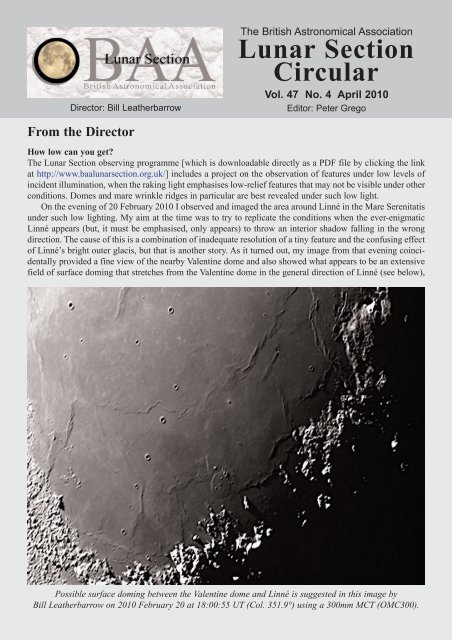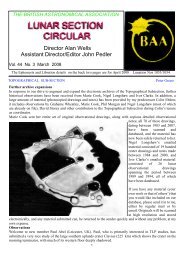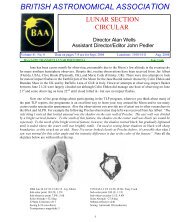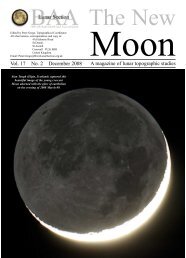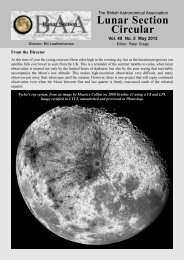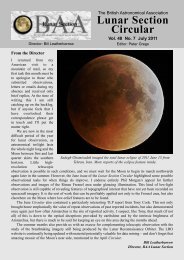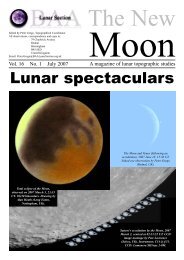Vol 47, No 4, April 2010 - BAA Lunar Section
Vol 47, No 4, April 2010 - BAA Lunar Section
Vol 47, No 4, April 2010 - BAA Lunar Section
You also want an ePaper? Increase the reach of your titles
YUMPU automatically turns print PDFs into web optimized ePapers that Google loves.
Director: Bill Leatherbarrow<br />
The British Astronomical Association<br />
<strong>Lunar</strong> <strong>Section</strong><br />
Circular<br />
<strong>Vol</strong>. <strong>47</strong> <strong>No</strong>. 4 <strong>April</strong> <strong>2010</strong><br />
Editor: Peter Grego<br />
From the Director<br />
How low can you get<br />
The <strong>Lunar</strong> <strong>Section</strong> observing programme [which is downloadable directly as a PDF file by clicking the link<br />
at http://www.baalunarsection.org.uk/] includes a project on the observation of features under low levels of<br />
incident illumination, when the raking light emphasises low-relief features that may not be visible under other<br />
conditions. Domes and mare wrinkle ridges in particular are best revealed under such low light.<br />
On the evening of 20 February <strong>2010</strong> I observed and imaged the area around Linné in the Mare Serenitatis<br />
under such low lighting. My aim at the time was to try to replicate the conditions when the ever-enigmatic<br />
Linné appears (but, it must be emphasised, only appears) to throw an interior shadow falling in the wrong<br />
direction. The cause of this is a combination of inadequate resolution of a tiny feature and the confusing effect<br />
of Linné’s bright outer glacis, but that is another story. As it turned out, my image from that evening coincidentally<br />
provided a fine view of the nearby Valentine dome and also showed what appears to be an extensive<br />
field of surface doming that stretches from the Valentine dome in the general direction of Linné (see below),<br />
Possible surface doming between the Valentine dome and Linné is suggested in this image by<br />
Bill Leatherbarrow on <strong>2010</strong> February 20 at 18:00:55 UT (Col. 351.9°) using a 300mm MCT (OMC300).
something I do not recall having seen so clearly before and something that is certainly not detectable under<br />
higher lighting conditions. It hints at a very active volcanic past in the general area (although I am not suggesting<br />
for one moment that Linné is anything other than a relatively ‘recent’ simple impact crater).<br />
I can find no mention of this doming, if that indeed is what it is, in the literature, and it would therefore<br />
be good to get further confirmation and better images and drawings of this, especially under low evening illumination.<br />
It may be argued that virtual results from space-probe elevation models will eventually render such observations<br />
redundant. I wonder if that will indeed turn out to be the case, given the extensive nature and very<br />
low relief of this kind of doming. Moreover, no virtual result can match the sheer magnificence of such features<br />
when they are revealed at the eyepiece by glancing light and ink-black shadows, and this alone is sufficient<br />
reason for continuing telescopic observations.<br />
The <strong>BAA</strong> annual Winchester weekend takes place on the 9-11 <strong>April</strong>. I am one of the speakers, and I hope to<br />
meet some <strong>Section</strong> members there. We have been offered the opportunity to hold a <strong>Lunar</strong> <strong>Section</strong> meeting<br />
during next year’s Winchester weekend, and I have provisionally accepted. I recognise that Winchester is not<br />
necessarily the most convenient location for all <strong>Section</strong> members (but then, where is), but it does offer us<br />
the chance to hold a meeting where there is a large ready audience and the possibility of drawing others into<br />
the <strong>Section</strong>. More information will become available in due course, but I do hope that in the meantime <strong>Section</strong><br />
members will make a mental note and consider making the trip to Winchester (and possibly contributing a<br />
short paper) in 2011.<br />
Bill Leatherbarrow<br />
Last chance to contribute articles for the final issue of The New Moon<br />
The final issue of the <strong>BAA</strong> <strong>Lunar</strong> <strong>Section</strong>’s journal, The New Moon, is currently being compiled. If any<br />
reader would like to contribute an article on any aspect of lunar observation or lunar science (past, present<br />
or future) please send it to me by email at editor@baalunarsection.org.uk before the end of <strong>April</strong>.<br />
After this final issue of TNM appears, we say a fond farewell to a journal whose contributors over the<br />
years have included many important figures in the field of selenography and selenology. The change is<br />
partly due to the fact that the <strong>Lunar</strong> <strong>Section</strong> Circulars have become larger and more elaborate, with more<br />
observations, analysis and theory than in past issues. It has often been difficult for me to decide whether<br />
to include an item in the LSC or to hold it over for publication in TNM.<br />
But don’t worry — a new journal will take its place. As the Director has mentioned in several previous<br />
<strong>Lunar</strong> <strong>Section</strong> Circulars, the intention is to produce an annual publication titled The Moon: <strong>No</strong>tes<br />
and Records of the <strong>BAA</strong> <strong>Lunar</strong> <strong>Section</strong> devoted to the dissemination of the more considered and detailed<br />
outcomes of members’ observations and of the observing programmes carried out by the <strong>Section</strong>. As Bill<br />
writes: “It would, in fact, be something like the old <strong>Section</strong> Memoirs and would serve to report the proceedings<br />
of the <strong>Section</strong> as a whole. It would publish more organised observational results and reports of<br />
work in progress, and its editors would be supported by an editorial board, something which would in<br />
my view enhance the standing of the publication.” There’s something we should all look forward to!<br />
Peter Grego<br />
Cloudwatch, February <strong>2010</strong><br />
Andrew Byntar<br />
Observer and location Excellent Cloudy Overcast Hazy <strong>No</strong> watch<br />
days days days days days<br />
P. Burt (Chatham) 1 (4%) 1 (4%) 23 (82%) 3 (11%) -----<br />
A. Bytnar (Mansfield) 6 (21%) 1 (4%) 20 (71%) 1 (4%) -----<br />
M. Cook (Cromer) 10 (36%) 6½ (23%) 9 (32%) 2½ (9%) -----<br />
K. Hall (Warrington) 7 (25%) 6 (21%) 12 (43%) 0 (0%) 3 (11%)<br />
A. Heath (<strong>No</strong>ttingham) 3 (11%) 6 (21%) 19 (68%) 0 (0%) -----<br />
J. Wrigley (Reading) 1½ (5%) 7½ (27%) 19 (68%) 0 (0%) -----<br />
Email: ASByt@aol.com<br />
2<br />
<strong>BAA</strong> <strong>Lunar</strong> <strong>Section</strong> Circular <strong>Vol</strong>. <strong>47</strong> <strong>No</strong>. 4 <strong>April</strong> <strong>2010</strong>
Topographical notes<br />
compiled by Peter Grego<br />
Visual studies and observations<br />
Since the last topographical notes in March’s LSC, lunar observational drawings and notes have been received<br />
from Peter Grego (St Dennis, Cornwall, UK), Dale Holt (Chipping, Hertfordshire, UK), Phil Morgan<br />
(Tenbury Wells, Worcestershire, UK), Rob Peeling (SPA member, Stockton-on-Tees, UK) and Graham<br />
Sparrow (SPA member, UK).<br />
Observation of a ‘sunset ray’ in Zeno<br />
Peter Grego<br />
<strong>No</strong>tes: A very favourable libration for this area near the northeastern limb presented this view of late evening<br />
over Zeno and environs very nicely indeed. My attention was captured on seeing the remarkable illumination<br />
of Zeno’s floor; most of it was in shadow save for a clean-cut illuminated triangular section of the floor,<br />
diverging from near the mid-western rim to the inner eastern wall — a so-called ‘sunset ray’. This was made<br />
even more remarkable by the presence of a dark shadow bisecting the eastern inner wall of Zeno A, almost<br />
in line with the ‘sunset ray’; this was likely partly caused by shadow from the small crater Zeno D, which lies<br />
between Zeno and Zeno A. Adjoining, the interior of Zeno B was completely shadowed except its upper inner<br />
eastern wall. The area was full of interest and rather crater-crowded. Traces of Zeno J’s remaining illuminated<br />
eastern rim were visible in the darkness beyond the terminator. Unlike many lunar highland regions, a<br />
number of smooth grey plains were to be found amid the craters here, notably northwest and southwest of<br />
Zeno and at the bottom of the sketch (towards Schumacher, which is not depicted as it lies outside of the area<br />
sketched). In order to depict the changing illumination of the area, a second observation was made around an<br />
hour after the first, using the original sketch as a template (one of the great advantages of cybersketching).<br />
By 01:05 UT the sunset ray in Zeno had faded considerably, the narrowing illuminated section of Zeno’s floor<br />
appearing duskier towards the west, and the edges of the bounding shadow were less distinct than before.<br />
Zeno J’s eastern rim had also faded considerably by this time. Some slight differences in detail between the<br />
sketches are due to copying up and enhancing each observation immediately after each session, plus there<br />
were differences in seeing and also various amounts of observational attention was paid to different areas at<br />
different times. A third observation, made between 01:40 and 01:50 UT, saw Zeno’s floor completely in shadow.<br />
Only a chink of light remained of Zeno J’s wall.<br />
<strong>BAA</strong> <strong>Lunar</strong> <strong>Section</strong> Circular <strong>Vol</strong>. <strong>47</strong> <strong>No</strong>. 4 <strong>April</strong> <strong>2010</strong> 3
<strong>No</strong>tes on last light in Posidonius<br />
Phil Morgan<br />
Following correspondence with<br />
Jim Mosher I received the email<br />
below enclosing his latest simulation<br />
for last light in Posidonius,<br />
and I though that you may all be<br />
interested in seeing this. Although<br />
this is an improvement on his first<br />
attempt, I have to admit that I<br />
found it a little difficult to ‘read’<br />
the first of the images to decide<br />
just which feature was which on<br />
the crater floor! If this simulation<br />
is correct then it looks as though it<br />
is a spot on the northwest rim of<br />
the crater A that is the last of the<br />
central floor objects to remain illuminated<br />
at sunset. Jim also provides<br />
a link to another series of<br />
simulations that he has prepared<br />
and one of these covers last light<br />
on Plato. Interesting, but it still<br />
doesn’t seem to agree with what I<br />
was seeing at the time! Perhaps on<br />
day someone will manage to take<br />
an image of the event, but even if<br />
they did would it provide us with<br />
all the answers<br />
From: Philip Morgan<br />
Subject: Last light on Posidonius<br />
To: Jim Mosher<br />
I was interested to learn on the<br />
December 6 LPOD<br />
http://lpod.wikispaces.com/Dece<br />
mber+6,+2009 that using your<br />
updated LTVT program and the<br />
Kaguya DEM it is now possible to<br />
recreate almost any lighting conditions<br />
in a given crater at a particular<br />
time. The reason for my interest<br />
is because for nearly a decade I<br />
have been trying to capture very<br />
last light on the floor of<br />
Posidonius to try and determine<br />
just which is the last feature on the<br />
floor to remain illuminated. At the<br />
moment I have narrowed it down<br />
to two objects — the southwest<br />
rim of the central crater A, and the<br />
4<br />
<strong>BAA</strong> <strong>Lunar</strong> <strong>Section</strong> Circular <strong>Vol</strong>. <strong>47</strong> <strong>No</strong>. 4 <strong>April</strong> <strong>2010</strong>
largest of the group of hills to the<br />
northeast of A. Despite getting up<br />
early probably hundreds of times, I<br />
just seem to keep on missing the<br />
very last light on the crater floor<br />
and am beginning to think that I<br />
may run out of time before I know<br />
the answer! Perhaps it is not possible<br />
for you to give me a definite<br />
answer, because like so many<br />
other lunar matters libration could<br />
effect things, but if you think that<br />
you could come up with something,<br />
I would be more than<br />
pleased to see the result!<br />
Re: Last Light on Posidonius<br />
From: Jim Mosher<br />
The first batch of data digital elevation<br />
data from the LOLA instrument<br />
on LRO were released this<br />
last Monday. The nominal resolution<br />
is about four times higher than<br />
the Kaguya DEM, so I thought you<br />
might be interest in the attached<br />
sequence of last light on<br />
Posidonius as predicted with this<br />
data set. The quality will improve<br />
as the spacecraft completes more<br />
orbits and populates the grid with<br />
data, and grids will even finer<br />
spacing will eventually be<br />
released. A rendering of Plato<br />
under the circumstances of your<br />
‘milky light’ observation can be<br />
seen<br />
at:<br />
http://ltvt.wikispaces.com/Digital<br />
+topography#PlatoLastLight<br />
The images featured on pages 4<br />
and 5 are <strong>Lunar</strong> Terminator<br />
Visualization Tool (LTVT) simulations<br />
of sunset over Posidonius<br />
based on LRO LOLA data and<br />
computed for 2008 July 7 at<br />
00:00, 02:30, 03:30 and 03:45<br />
UT respectively. Images courtesy<br />
Jim Mosher.<br />
<strong>BAA</strong> <strong>Lunar</strong> <strong>Section</strong> Circular <strong>Vol</strong>. <strong>47</strong> <strong>No</strong>. 4 <strong>April</strong> <strong>2010</strong> 5
Above: Dale Holt’s observational sketch of Aristoteles, made with a 150mm refractor, 270x, on <strong>2010</strong><br />
February 20 at 20:00 UT (Col. 352.8°); compare this with a CCD image of Aristoteles and Eudoxus taken<br />
by Bill Leatherbarrow on the same evening at 17:58:45 UT (Col. 351.9°) using a 300mm MCT (OMC300).<br />
Below: A detail from Bill Leatherbarrow’s CCD image of the lunar southern highlands, centred on the<br />
crater Maurolycus, taken on <strong>2010</strong> February 20 at 17:45:59 UT (Col. 351.8°) using a 300mm MCT<br />
(OMC300). Compare this with Graham Sparrow’s sketch of Maurolycus made on the same evening at<br />
18:30-50 UT (Col. 352.0-352.2°) using a 200mm Newtonian, 200x.<br />
6<br />
<strong>BAA</strong> <strong>Lunar</strong> <strong>Section</strong> Circular <strong>Vol</strong>. <strong>47</strong> <strong>No</strong>. 4 <strong>April</strong> <strong>2010</strong>
Manilius and nearby dome-like elevations<br />
Phil Morgan reports: ‘I made a sketch of what appeared to be a very large and rough dome just northeast of<br />
the crater Manilius on the evening of <strong>2010</strong> February 20 (above, right). Just like the previous observation I<br />
was limited to only about 20 minutes of clear sky, so again a rather rushed effort to get things down before<br />
lights out. I have to say that I have no certain information that this is indeed a large dome. All I can say is that<br />
it looked like one at this colongitude, and just like Rumker it had a rough and lumpy summit area. It could be<br />
just the denuded remains of a once grand mountain mass. I’ve tried to find some images at a similar colongitude,<br />
but with only limited success. All that I found was the rather low-res image on page 92 of the Atlas of<br />
the <strong>Lunar</strong> Terminator taken Col. 351°. If you should know of anything else or have any information I would<br />
be pleased to see it.’<br />
On checking the SPA/<strong>BAA</strong> <strong>Lunar</strong> <strong>Section</strong> database there were two other observations of Manilius, one by<br />
Massimo Chiarini (2000 February 12) and the other by Grahame Wheatley (2001 October 23). Massimo’s<br />
observation shows just the crater at a different illumination to Phil’s, but in one of those remarkable coincidences<br />
we’re sometimes treated to, Grahame’s observation (featured above, left) depicts almost precisely the<br />
same area as Phil’s, and it is made under nearly the same illumination conditions (a slightly lower Sun in<br />
Grahame’s). As might be expected of two such skilled observers, they show a very good degree of congruence;<br />
the dome-like elevation mentioned by Phil is also shown in Grahame’s observation. I tend towards the<br />
idea that the features represent pre-mare flooding heights that were covered with lava.<br />
Join us at our Yahoo! Group — topographic studies<br />
If you’d like to see more of the <strong>BAA</strong> <strong>Lunar</strong> <strong>Section</strong>’s observations, along with some of those mentioned<br />
in this LSC, you’re most welcome to join our Yahoo! Group at:<br />
http://uk.groups.yahoo.com/group/baalunarsection-topography/<br />
It’s easy to join – simply follow the on-screen instructions and I will sign you in as quickly as possible.<br />
Peter Grego<br />
<strong>BAA</strong> <strong>Lunar</strong> <strong>Section</strong> Circular <strong>Vol</strong>. <strong>47</strong> <strong>No</strong>. 4 <strong>April</strong> <strong>2010</strong> 7
A note on Torricelli<br />
Bill Leatherbarrow<br />
This note is by way of a follow-up to Peter Grego’s fine survey of the Torricelli region, which appeared in the<br />
October 2009 issue of The New Moon (<strong>Vol</strong>. 18, <strong>No</strong>. 1). Peter mentions the debris on the floor of this crater<br />
and attributes this to slumping of the eastern wall. This is an entirely likely explanation, given the tendency<br />
for craters of this intermediate size to produce such wall slumps instead of full-scale terracing. The image<br />
above, from 1 <strong>April</strong> 2009 and taken with a 9.25-inch SCT, shows this floor material.<br />
The second image, below (20 February <strong>2010</strong>) was taken under poorer conditions and without amplification,<br />
with an OMC300. The wider field of view offered by the lower magnification allows us to see Torricelli<br />
in the context of the impressive<br />
impact ejecta field from the larger<br />
and apparently younger crater<br />
Theophilus. (Mike Brown’s image<br />
from 8 October 2009, which accompanied<br />
Peter’s paper, also allows a<br />
fine view of this context.)<br />
These wider-field images make<br />
me wonder whether an alternative<br />
explanation for the floor debris<br />
within Torricelli might not be that it<br />
represents ejecta deposits from the<br />
impact that produced Theophilus It<br />
might be worth further study of the<br />
disposition of the debris material<br />
within Torricelli, especially under<br />
different angles of illumination.<br />
8<br />
<strong>BAA</strong> <strong>Lunar</strong> <strong>Section</strong> Circular <strong>Vol</strong>. <strong>47</strong> <strong>No</strong>. 4 <strong>April</strong> <strong>2010</strong>
Phil notes: Another study of Alhazen Alpha under late afternoon light and a very favourable libration. I’ve<br />
also added a sequence of observations of this feature throughout the lunation to my <strong>BAA</strong> Yahoo! site photo<br />
album (see http://uk.groups.yahoo.com/group/baalunarsection-topography/). Looking through these it seems<br />
though the bands on the sunlit face of Alhazen Alpha move through the course of a lunation, and this makes<br />
me wonder if (up to a point) we are observing shadow effects Very difficult to be sure — and a set of images<br />
would be more accurate. The trouble is that the bands do not seem to show up particularly well on photos!<br />
<strong>BAA</strong> <strong>Lunar</strong> <strong>Section</strong> Circular <strong>Vol</strong>. <strong>47</strong> <strong>No</strong>. 4 <strong>April</strong> <strong>2010</strong> 9
CCD images<br />
Since the last report in March’s LSC lunar CCD images have been received from Mike Brown (Huntington,<br />
York, UK), Maurice Collins (Palmerston <strong>No</strong>rth, New Zealand), Ed Crandall (Lewisville, NC, USA), Dave<br />
Finnigan (Halesowen, UK), Peter Garbett (UK), Bill Leatherbarrow (Sheffield, UK), Peter Meadows<br />
(Chelmsford, UK), David Scanlan (Romsey, UK), Mike White (Levin, New Zealand) and Philip Withers<br />
(UK).<br />
Extreme close-up of an image taken by Mike Brown on <strong>2010</strong> February 20 showing Rima Sosigenes and the<br />
discovery of a trench-like feature (arrowed) apparently being overlaid by the rille itself.<br />
10<br />
<strong>BAA</strong> <strong>Lunar</strong> <strong>Section</strong> Circular <strong>Vol</strong>. <strong>47</strong> <strong>No</strong>. 4 <strong>April</strong> <strong>2010</strong>
Close-up of Mike Brown’s image above, showing great detail in Theophilus and Cyrillus.<br />
<strong>BAA</strong> <strong>Lunar</strong> <strong>Section</strong> Circular <strong>Vol</strong>. <strong>47</strong> <strong>No</strong>. 4 <strong>April</strong> <strong>2010</strong> 11
Great close-up detail is visible in Mike White’s image. Schiller-Schickard (left), Kepler-Marius (right).<br />
12<br />
<strong>BAA</strong> <strong>Lunar</strong> <strong>Section</strong> Circular <strong>Vol</strong>. <strong>47</strong> <strong>No</strong>. 4 <strong>April</strong> <strong>2010</strong>
Rima Ariadaeus and<br />
the Julius Caesar area<br />
is captured under a<br />
morning illumination<br />
in this image by<br />
Ed Crandall taken on<br />
<strong>2010</strong> February 20 at<br />
23:12 (Col. 355°)<br />
under AIII seeing and<br />
twilight conditions.<br />
Ed used a 110mm APO<br />
f/6.5 + 3x Barlow +<br />
Toucam.<br />
<strong>BAA</strong> <strong>Lunar</strong> <strong>Section</strong> Circular <strong>Vol</strong>. <strong>47</strong> <strong>No</strong>. 4 <strong>April</strong> <strong>2010</strong> 13
<strong>BAA</strong>/ALPO Transient <strong>Lunar</strong> Phenomena<br />
Tony Cook<br />
Observations for February <strong>2010</strong> were received from the following observers: Jay Albert (Lakeworth, FL,<br />
USA), Maurice Collins (New Zealand), myself (Newtown, and Aberystwyth University, UK), Marie Cook<br />
(Mundesley, UK), Steve Lang (New Zealand), Brendan Shaw (UK), and Mike White (New Zealand)<br />
TLP Reports: <strong>No</strong> TLP reports were received for February <strong>2010</strong>. However three non-lunar surface related<br />
events were reported along the line of site to the Moon : On <strong>2010</strong> Feb 21 at UT 07:35 Maurice Collins<br />
(Palmerston <strong>No</strong>rth, New Zealand) observed a satellite transiting across the disk of the Moon. Using the<br />
Heavens Above satellite prediction web site, he was able to deduce that it was a French spy satellite called<br />
Helios 1B moving at 0.25 degrees per second. Figure 1 (below) shows the path of the satellite superimposed<br />
on an image that he took prior to<br />
the transit. Satellite passages<br />
across the lunar disk are quite<br />
common and can occur several<br />
times per night, however the illumination<br />
conditions have to be<br />
correct to see them. Also on Feb<br />
21, but much later at 21:08UT I<br />
saw visually (from Newtown, UK)<br />
a brief < 0.1 second magnitude 8-9<br />
flash of light, about 100-150 km<br />
beyond the limb, NW of the north<br />
pole. Almost certainly this was a<br />
cosmic ray that my eye detected,<br />
but I am noting it anyway just in<br />
case it was sun glint off the lost<br />
lunar orbiter Chandrayan-1 (see<br />
the TLP article from the LSC 2009<br />
Oct). Please report such events in<br />
case they are spacecraft related as<br />
Figure 1. Passage of Helios 1 across the Moon as seen by<br />
Maurice Collins on <strong>2010</strong> February 20.<br />
this would help to determine its<br />
orbit. Finally, on <strong>2010</strong> Feb 26 at<br />
22:01UT a robotic telescope at<br />
Aberystwyth, that I was using,<br />
recorded a flock of birds in a nearly “V-shaped” formation (probably starlings) passing across the disk of the<br />
Moon in video recording. These can be seen in Figure 2 in 3D if you have stereo anaglyph glasses. If these<br />
were Starlings then, with a wing span of 40cm, then they must have been at a distance of approximately 1.2<br />
km away – and this accounts for the blurred nature of their silhouettes because the telescope was focused on<br />
infinity.<br />
<strong>Lunar</strong> and Planetary Science Conference: Two page abstracts for this year’s 41st <strong>Lunar</strong> and Planetary<br />
Science Conference at The Woodlands, Texas (<strong>2010</strong> Mar 1-5) are available online to read on<br />
http://www.lpi.usra.edu/meetings/lpsc<strong>2010</strong>/ . These abstracts are very educational to browse through in order<br />
to see what the latest news is in the planetary sciences. This year they cast some light on some recent results<br />
from the LCROSS impact, LRO results and other missions, and the latest theories on lunar dust, and volatiles<br />
in the lunar regolith. I will summarize the latest theories on lunar dust and volatiles in the lunar regolith and<br />
detail here some of the findings from the LRO:<br />
Firstly Crotts and Hummels from Columbia University, NY, has calculated that a seepage flow of 2 grams<br />
per second of gas at a regolith depth of 15 meters is enough (1 tonne of pressure of gas molecules with a mass<br />
equivalent to 20 times the weight of a hydrogen atom) to explosively erupt through the regolith. Although the<br />
heavier particles churned up would fall back into the pit, the lighter ones could expand for several minutes<br />
over several kilometers area, which by chance is the size and duration of a typical event that is needed for a<br />
14<br />
<strong>BAA</strong> <strong>Lunar</strong> <strong>Section</strong> Circular <strong>Vol</strong>. <strong>47</strong> <strong>No</strong>. 4 <strong>April</strong> <strong>2010</strong>
LTP to be seen from Earth. They further speculate that charge separation within part of the cloud of dust could<br />
cause coronal discharge effects. The authors also discuss how their model of gas seepage had predicted correctly<br />
the distribution of hydrated lunar regolith, within about 20 degrees of each lunar pole, discovered in<br />
2009. They do not comment though on why the Apollo instruments did not detect such large amounts of gas<br />
being added to the lunar atmosphere.<br />
Concerning the electrostatic levitation of dust particles on the Moon, Poppe and Horanyi of the University<br />
of Colorado have been carrying out computational simulations on the process in a one dimensional model,<br />
The theory goes that ultraviolet light from the Sun causes photoemission from the lunar surface and solar<br />
wind plasma should give the lunar surface a negative charge. However the electrical current from the photoemission<br />
is roughly ten times greater than the solar wind electrical current and so the lunar surface is charged<br />
positively. Something called a photoelectron sheath develops and can form up to several meters thick above<br />
the surface. They find that downward directional electric fields in the photoelectron sheath limit the height to<br />
which dust particles can levitate and it becomes significantly more difficult to levitate particles larger than<br />
0.15 microns in size. For future work they will model the process in two dimensional simulations and will<br />
also vary UV flux and solar wind conditions, but for now their models dispute some of the evidence for electrostatic<br />
dust particles attaining much altitude at all.<br />
Conversely Glenar et al. (New Mexico State University) discuss whether the 1994 Clementine mission<br />
observed horizon glow from dust particles suspended a hundred km above the lunar surface from the spacecraft’s<br />
star tracker cameras! Their conclusions, after removing the effects of zodiacal light, and the corona etc,<br />
hint that it does exist and they are now studying the spatial distribution of the horizon glow along the limb.<br />
Jackson et al. (Goddard Space Flight Center) submitted an abstract to the conference, expressing concern<br />
about tribo-electric discharge hazard faced by astronauts, especially at the polar regions near to permanently<br />
shadowed craters. Hartzell and Scheeres of the University of Colorado have been studying what happens if<br />
lunar water is present on dust particles at the parts per million level. There conclusion is that this reduces the<br />
cohesive force between dust particles and the surface and this can increase the chances of levitation should a<br />
particle become charged, furthermore the effect would be more prevalent at sunrise than at sunset and this is<br />
what is observed. They do however not discuss the precise mechanism for charging; I guess a lot of theoretical<br />
work still needs to be achieved in this research area to match the observational evidence!<br />
Finally, you may be interested to know that LRO’s Lyman Alpha Mapping Project (LAMP), a far ultraviolet<br />
imaging spectrograph that detected molecular hydrogen, mercury, calcium and magnesium volatiles in<br />
the ejecta plume of the LCROSS impact, will be used to monitor horizon glow at dawn, according to<br />
Gladstone and the LAMP team from the Southwest Research Institute. They hope to detect gaseous emissions<br />
from the surface, sodium emissions, dust particles during meteor showers, and other effects during crossings<br />
of the Earth’s magnetotail.<br />
Figure 2. Flock of birds passing across the Moon from Aberystwyth. To view as a 3D Anaglyph, please use<br />
red and green/blue glasses with red over the left eye and Green/blue over the right eye. The left and right<br />
images, in this stereo pair, are separated by 1/60th second<br />
<strong>BAA</strong> <strong>Lunar</strong> <strong>Section</strong> Circular <strong>Vol</strong>. <strong>47</strong> <strong>No</strong>. 4 <strong>April</strong> <strong>2010</strong> 15
Suggested Features to observe in <strong>April</strong>: For those of you without access to the internet (in the UK), below<br />
is a list of repeat conditions for when a feature will exhibit the same illumination and libration as was seen<br />
for a historical TLP observation from the past. By re-observing and submitting your observations, we will get<br />
a clear understanding of what the feature ought to have looked like at the time. Only this way can we really<br />
fully analyze past TLP reports.<br />
<strong>2010</strong>-Apr-16 UT 19:03-20:12 Ill=5% S_Pole observed by Firsoff on 1956-3-14<br />
South Cusp 1956 Mar 14 UT 19:00 Observed by Firsoff (Somerset, England, 5” reflector) “Twilight at<br />
S.cusp traced 640 km beyond cusp. <strong>No</strong> trace of twilight at N. pole” NASA catalog weight=4 (good). NASA<br />
catalog ID #635.<br />
<strong>2010</strong>-Apr-17 UT 19:<strong>47</strong>-20:38 Ill=12% Earthshine: sporadic meteors<br />
<strong>2010</strong>-Apr-18 UT 19:49-21:38 Ill=20% Earthshine: sporadic meteors<br />
<strong>2010</strong>-Apr-19 UT 19:51-22:31 Ill=30% Earthshine: sporadic meteors<br />
<strong>2010</strong>-Apr-20 UT 19:53-23:34 Ill=41% Earthshine: Lyrids: ZHR=18 vel=48km/s & Eta Puppids:<br />
ZHR=
<strong>2010</strong>-Apr-29 UT 02:52-03:40 Ill=99% Hyginus_N observed by Klein_HJ on 1877-5-27<br />
Hyginus <strong>No</strong>va 1877 May 27 UT 20:37 Observed by Klein (Cologne, Germany) NASA Catalog Event #190,<br />
NASA Weight=1 (Very Low). Event described as: “New crater 3mi.diam Didn’t see anything there 12 yrs.previously<br />
in studies. (Schmidt showed it sometimes dark, sometimes light, sometimes not at all. Neison studied<br />
region minutely 20x from July 1870-Aug,1875 & did not record it. Gauth says it’s not new (changes there)<br />
“References: Neison, E. The Moon, Longmans, Green and Co., London, 1876; Astron. Reg. 17, 204, 1877<br />
For repeat illumination TLP predictions for the coming month, these can be found on the following web site:<br />
http://users.aber.ac.uk/atc/tlp/tlp.htm .For members who do not have access to the internet, please drop me a<br />
line and I will post predictions to you. If you would like to join the TLP telephone alert team, please let me<br />
know your phone <strong>No</strong>. and how late you wish to be contacted. If in the unlikely event you see a TLP, please<br />
give me a call on my cell phone: +44 (0)798 505 5681 and I will alert other observers. <strong>No</strong>te when telephoning<br />
from outside the UK you must not use the (0). When phoning from within the UK please do not use the<br />
+44! Twitter TLP alerts can be accessed on http://twitter.com/lunarnaut.<br />
Dr Anthony Cook, Institute of Mathematical and Physical Sciences, University of Wales<br />
Aberystwyth, Penglais, Aberystwyth, Ceredigion, SY23 3BZ, Wales, United Kingdom.<br />
Email: atc @ aber.ac.uk<br />
LROC image release<br />
Anthony Cook draws our atention to the fact that the <strong>Lunar</strong> Reconnaisance Orbiter Camera (LROC) PDS<br />
Archive went live online on March 15. The complete set of science data from LROC’s first six months<br />
of observations, consisting of more than 100,000 lunar images is now accessible online on<br />
http://wms.lroc.asu.edu/lroc#damoon<br />
For starters, Anthony recommends taking a look at the rather strange Ina formation, an 8 square kilometre<br />
D-shaped area in Lacus Felicitatis which is likely to have been a site of relatively recent (ie,
Occultation news<br />
Andrew Elliott<br />
One graze is predicted for <strong>April</strong>. Track 9<br />
in the February LSC (shown at right, red<br />
line; the track is not mentioned in the <strong>BAA</strong><br />
Handbook due to low elevation) crosses<br />
parts of SW RoI and western Cornwall<br />
commencing at around 22<strong>47</strong> UT (23<strong>47</strong><br />
BST) on the night of Thursday <strong>April</strong> 29th.<br />
The 5.0 magnitude star ZC2237 (HIP<br />
76742, 42 Lib) will be grazed by the<br />
northern limb of the 97% sunlit Moon<br />
against the dark limb but close to the terminator.<br />
The Moon will be at just 8° elevation,<br />
in azimuth 144° (SE). The graze<br />
area of the lunar limb is in the Cassini<br />
region, so is expected to be quite rough,<br />
with multiple events possible in the 2km<br />
zone SW of the track. These conditions<br />
are quite difficult but a larger telescope<br />
should be quite adequate.<br />
Predictions for 1°44’44.0”W 52°27’41.4”N Alt. 50m, (Birmingham) Tel diam 150mm – Apr <strong>2010</strong><br />
Key to less obvious column entries in predictions:<br />
Predictions are computed for a telescope aperture of 150mm using a detailed observability algorithm.<br />
Lower case D, R, Gr in Phase column means the star is within 1 magnitude of observability limit, i.e. less<br />
easy to see. M, or m, indicate a bright star miss at the above coordinates, but which may be an occultation<br />
nearby. Star catalogue, nnnn = ZC, nnnnn or nnnnnn = SAO, Xnnnnn = XZ80, nnnn = other catalogue,<br />
where ‘’ is a letter indicating the catalogue. Character in ‘D’ column indicates a double star – careful timing/video<br />
recording may reveal the duplicity. Character in ‘V’ column indicates a variable star. (Extra<br />
information lines for double/variable stars removed to save space.) Other entries are as for the pre-2007<br />
predictions produced by OCCMOON in previous LSCs. Predictions courtesy of David Herald’s Occult program,<br />
version 3.6.<br />
Andrew Elliott, White Lodge, Bank Lane, Warton, Preston, PR4 1TB, United Kingdom.<br />
Email: occultation@baalunarsection.org.uk<br />
18<br />
<strong>BAA</strong> <strong>Lunar</strong> <strong>Section</strong> Circular <strong>Vol</strong>. <strong>47</strong> <strong>No</strong>. 4 <strong>April</strong> <strong>2010</strong>
<strong>Lunar</strong> phases<br />
<strong>April</strong> <strong>2010</strong><br />
<strong>Lunar</strong> librations<br />
<strong>April</strong> <strong>2010</strong><br />
<strong>BAA</strong> <strong>Lunar</strong> <strong>Section</strong> Circular <strong>Vol</strong>. <strong>47</strong> <strong>No</strong>. 4 <strong>April</strong> <strong>2010</strong> 19
<strong>Lunar</strong> data <strong>April</strong> <strong>2010</strong><br />
<strong>Lunar</strong> phases<br />
Lunation New Moon First Quarter Full Moon Last Quarter<br />
1079 -- -- -- -- <strong>April</strong> 06, 09:38<br />
1080 <strong>April</strong> 14, 12:29 <strong>April</strong> 21, 18:20 <strong>April</strong> 28, 12:18 --<br />
Physical Data<br />
From computation program by Gareth Williams<br />
Earth's<br />
Sun’s<br />
<strong>2010</strong> Age Selenographic Selenographic R.A. Dec. Rises Sets Transit Alt<br />
APR. d Phase Longø Latø Colongø Latø h m ø h m h m h m ø<br />
----- ----- ----- ----- ---- ------ ---- ----- ----- ----- ----- ----- ---<br />
1.0 16.1 0.950 5.7 6.1 109.8 1.53 14 11 -18.2 22 27 06 00 01 37 19<br />
2.0 17.1 0.891 6.4 5.4 121.9 1.53 15 08 -21.9 .. .. 06 31 02 32 15<br />
3.0 18.1 0.816 6.6 4.4 134.1 1.54 16 05 -24.3 .. .. 07 10 03 27 13<br />
4.0 19.1 0.730 6.4 3.2 146.3 1.54 17 02 -25.3 00 45 08 00 04 22 12<br />
5.0 20.1 0.636 5.8 1.9 158.4 1.54 17 57 -24.9 01 34 09 00 05 15 13<br />
6.0 21.1 0.540 4.8 0.5 170.6 1.55 18 51 -23.4 02 12 10 06 06 06 15<br />
7.0 22.1 0.444 3.6 -0.8 182.8 1.55 19 42 -20.8 02 40 11 15 06 53 18<br />
8.0 23.1 0.351 2.2 -2.2 195.0 1.55 20 30 -17.3 03 02 12 25 07 38 21<br />
9.0 24.1 0.265 0.8 -3.4 207.2 1.55 21 16 -13.2 03 20 13 34 08 21 26<br />
10.0 25.1 0.186 -0.6 -4.5 219.4 1.55 22 00 -8.6 03 35 14 43 09 02 31<br />
11.0 26.1 0.118 -1.8 -5.4 231.6 1.55 22 44 -3.6 03 49 15 52 09 43 36<br />
12.0 27.1 0.064 -2.9 -6.0 243.9 1.54 23 27 1.5 04 02 17 02 10 24 41<br />
13.0 28.1 0.025 -3.8 -6.5 256.1 1.54 00 12 6.6 04 17 18 13 11 06 46<br />
14.0 29.1 0.005 -4.4 -6.6 268.3 1.53 00 58 11.6 04 33 19 28 11 51 51<br />
15.0 0.5 0.004 -4.9 -6.3 280.5 1.53 01 <strong>47</strong> 16.2 04 52 20 43 12 39 56<br />
16.0 1.5 0.025 -5.1 -5.8 292.8 1.52 02 38 20.1 05 18 21 58 13 30 59<br />
17.0 2.5 0.067 -5.1 -5.0 305.0 1.51 03 33 23.1 05 51 23 09 14 25 62<br />
18.0 3.5 0.130 -5.0 -3.8 317.2 1.50 04 31 24.8 06 37 .. .. 15 22 63<br />
19.0 4.5 0.211 -4.7 -2.5 329.4 1.49 05 31 25.1 07 36 .. .. 16 20 62<br />
20.0 5.5 0.307 -4.3 -0.9 341.6 1.48 06 31 23.9 08 48 00 58 17 18 60<br />
21.0 6.5 0.415 -3.7 0.6 353.9 1.<strong>47</strong> 07 30 21.3 10 08 01 35 18 14 56<br />
22.0 7.5 0.528 -2.9 2.2 6.1 1.46 08 27 17.4 11 32 02 03 19 08 51<br />
23.0 8.5 0.641 -1.9 3.7 18.2 1.45 09 22 12.4 12 57 02 25 19 59 45<br />
24.0 9.5 0.7<strong>47</strong> -0.8 4.9 30.4 1.44 10 16 6.7 14 22 02 44 20 49 39<br />
25.0 10.5 0.841 0.5 5.8 42.6 1.43 11 08 0.7 15 46 03 01 21 39 33<br />
26.0 11.5 0.916 1.8 6.4 54.8 1.43 12 00 -5.4 17 11 03 18 22 30 27<br />
27.0 12.5 0.968 3.1 6.5 67.0 1.42 12 53 -11.2 18 36 03 37 23 23 21<br />
28.0 13.5 0.995 4.2 6.3 79.1 1.41 13 48 -16.3 19 59 04 00 .. .. ..<br />
29.0 14.5 0.996 5.0 5.6 91.3 1.40 14 44 -20.4 21 18 04 27 00 16 17<br />
30.0 15.5 0.972 5.5 4.7 103.5 1.39 15 42 -23.3 22 27 05 03 01 10 14<br />
20<br />
<strong>BAA</strong> <strong>Lunar</strong> <strong>Section</strong> Contacts<br />
Director<br />
Bill Leatherbarrow<br />
director@baalunarsection.org.uk<br />
Assistant Directors<br />
Tony Cook (with responsibility for TLP work)<br />
tlp@baalunarsection.org.uk<br />
Peter Grego (Circulars Editor)<br />
editor@baalunarsection.org.uk<br />
Committee Members<br />
Andrew Elliott (Occultations)<br />
occultation@baalunarsection.org.uk<br />
Robert Garfinkle (Historical Consultant)<br />
history@baalunarsection.org.uk<br />
Bruce Kingsley (Imaging Consultant)<br />
photography@baalunarsection.org.uk<br />
Nigel Longshaw<br />
Brendan Shaw (Archivist)<br />
archives@baalunarsection.org.uk<br />
Mike Carson-Rowland (Computing Consultant)<br />
compute@baalunarsection.org.uk<br />
To receive B&W printed copies of the <strong>Lunar</strong> <strong>Section</strong><br />
Circular, please send a supply of stamped addressed<br />
envelopes to the <strong>Lunar</strong> <strong>Section</strong> Director. Envelopes at<br />
least 11 x 22 cm will ensure no damage in transit.<br />
Members who have Internet access may receive their<br />
Circulars (colour version) in PDF format by email<br />
(please contact the Director) or by downloading them<br />
directly from the <strong>BAA</strong> <strong>Lunar</strong> <strong>Section</strong> website at<br />
http://www.baalunarsection.org.uk/circulars.htm.<br />
<strong>BAA</strong> <strong>Lunar</strong> <strong>Section</strong> Director: Bill Leatherbarrow,<br />
9 Stumperlowe Avenue, Sheffield, S10 3QN, UK.<br />
Email: director@baalunarsection.org.uk<br />
Observations and items related to a specific area of<br />
lunar study should be sent to the appropriate member of<br />
the <strong>BAA</strong> <strong>Lunar</strong> <strong>Section</strong> Committee, but send any material<br />
of a more general nature to the Editor. Deadline for<br />
items for the May <strong>Lunar</strong> <strong>Section</strong> Circular:<br />
10 <strong>April</strong> <strong>2010</strong>.<br />
Circulars Editor: Peter Grego, 7 Parc-An-Bre Drive,<br />
St Dennis, St Austell, Cornwall, PL26 8AS, UK.<br />
Email: editor@baalunarsection.org.uk<br />
<strong>BAA</strong> <strong>Lunar</strong> <strong>Section</strong> Circular <strong>Vol</strong>. <strong>47</strong> <strong>No</strong>. 4 <strong>April</strong> <strong>2010</strong>


